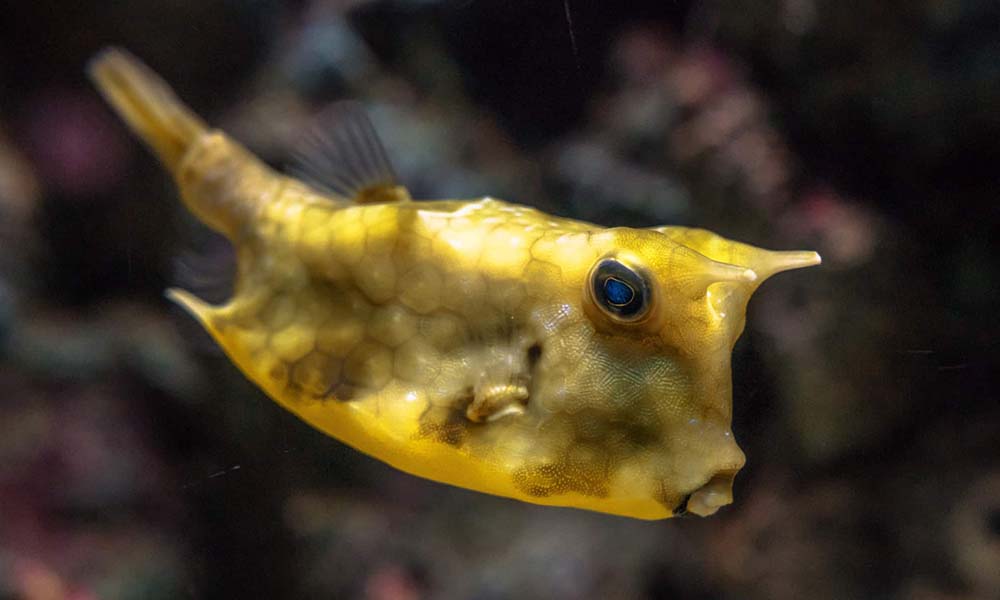Boxfish are known for their armored bodies, colorful dotted patterns, and release of toxins during stress. There are 25 species in 6 different genres of these warm-water creatures. Yellow boxfish is among the most common.
Content Table
This article will discuss the basic information about this fish and how many boxfish you can keep in a tank. A comparison between cowfish and boxfish is also in the scope of this article. Why it’s hard to keep them in a home aquarium is also interesting to know. All of this is just on your scroll.

Yellow boxfish
Is a Box Fish a Puffer Fish?
Yes, boxfish are closely related to pufferfish. Both share the same order, i.e., Tetraodontiformes. This small group of fish live in shallow, warm, and tropical seas around the globe. Boxfish are marine fish with a unique box-like body, mostly covered with carapace. This body structure slows their swimming, but they defend themselves by secreting toxins from their skin.
Some family members have a distinctive shape, i.e., hornlike projection on their heads. Therefore, they are known as cowfish. Cofferfishes and trunkfishes are other common names of this unique species. Here is general information about boxfish.
| Feature | Attribute |
| Family | Ostraciidae |
| Order | Tetraodontiformes |
| Common names |
|
| Body shape | Cube-like, boxy |
| Body covering | Fused plates, i.e., carapace, cover the whole body except the eyes, low-set mouth, fins, and tail. |
| Size | 10-50 cm (varies with age) |
| Color | Juvenile: brightly dotted pattern body Adult: color fades with time |
| Fins | Small pectoral and dorsal fins |
| Habitat | Coral reefs, lagoons, and seagrass beds in warm and tropical oceans |
| Distribution | Indian Pacific, and Atlantic Oceans |
| Diet | Omnivorous |
| Species | There are 25 different species, while some commons are as follows
|
Discover the Yellow Boxfish
It’s one of the most famous boxfish species, inhabiting the coral reefs of the Pacific and Indian Oceans. However, researchers found its occasional presence in the southeastern Atlantic Ocean. Researchers stated that the Suez Canal transported them into the Atlantic water.
Name and Coloration
Their appearance gives them this name, i.e., yellow boxfish. They have yellow box-like bodies with fused hard structure covering, i.e., carapace. This color is visible in juveniles, but brightness fades with age. Old fish turn from blue-grey to black.
Diet
They mainly eat marine algae. However, they solely don’t depend on it but also eat
| Worms | Crustaceans | Small fish |
| Sponges | Mollusc |
Breeding
They breed during spring. Usually, a group contains about 1 male and 2 to 4 female yellow fish. After mating, female fish lay the eggs, and males fertilize them.
Defence Mechanism
They can grow up to 18 inches long. Due to carapace, they lack agility and a high swimming pace. However, they release neurotoxin tetrodotoxin when they sense danger or get stressed. This neurotoxin creates distress and even can prove lethal for predators.
Distribution
They are distributed mainly around Indian coasts. It includes
| Lakshadweep island | Lakshadweep island |
| Nicobar islands | Nicobar islands |

Boxfish
How Many Boxfish Are in a Tank?
Although boxfish are beautiful, it doesn’t mean anyone can keep them. Only the experienced aquarists can handle their beauty.
How many boxfish are in a tank?
Only keep one fish in a tank. If you have a giant tank, i.e., 1000 gallons, you can keep 1 more to form a pair. They are territorial to the same species. They are not suitable to keep with others as they release a neurotoxin. It can prove lethal for other creatures.
Suitable tank size
Usually, it minimally ranges between 125 and 180 gallons according to different species.
| Species | Tank Size (gallon) |
| Yellow boxfish | 125 |
| Black boxfish | 180 |
| Longhorn Cowfish | 100 |
| Scrawled Cowfish | 180 |
Why Are Boxfish Hard to Keep
As said, they are only suitable for veterans. Here are some reasons why they are.
Toxin Release
On stress, they release a neurotoxin, harmful to other companions. Sometimes, this toxin can prove lethal. Like Hawaiian Boxfish, release lethal toxins that can break down the red blood cells of companions.
Large Tank Size
They lack agility and are not excellent swimmers. Therefore, they need a large swimming area. They will be the only fish in such a large tank, which requires extra time and effort from aquarists for proper management.
Sensitive
Boxfish are highly sensitive. With any change in water parameters, especially high Ammonia, they become stressed. Therefore, you must manage all water parameters, which is a veteran thing.

How many boxfish
Cowfish vs Boxfish
Cowfish and boxfish are the same, i.e., two names of one thing. However, here are some differences between them.
| Cowfish | Boxfish |
| Box body with horn-like head structure | Box body without specific structure |
| It has famous Longhorn Cowfish and Scrawled Cowfish species. | It has Yellow Boxfish and Smooth Trunkfish famous species |
| They can grow up to 20 inches | They can grow between 6 and 18 inches |
| Swim faster | Relatively swim slower |
Final Thoughts
Boxfish are present in warm waters of the Indian, Atlantic, and Pacific oceans. Yellow boxfish, Longhorn Cowfish, and Scrawled Cowfish are some common carapace toxin-releasing species. Yellow boxfish is the most common of all. Its color and body shape gave it this name.
It’s suitable only to keep a fish in a large tank as they feel uncomfortable with other fish and harm to them. Although cowfish and boxfish are the same, they differ in swimming speed.



Leave a comment